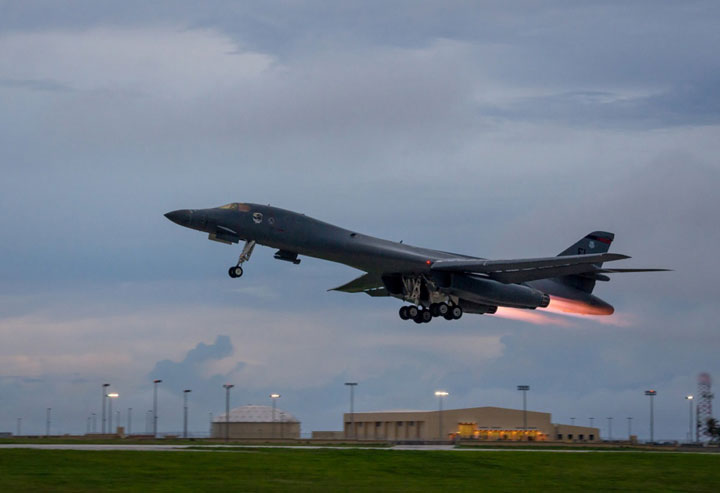WASHINGTON – Does the ominous rhetoric from President Donald Trump and repeated flights by U.S. strategic bombers over the Korean Peninsula mean Washington is readying for what many feel is unthinkable – a military conflict with a nuclear-armed North Korea that would put millions of civilians at risk?

U.S. B-1B bombers flew this week over South Korea with fighter jet escorts from the allied nation, in what’s become an increasingly familiar show of force to Pyongyang. It came just days after Trump said “only one thing will work” with North Korea and referred, ambiguously, to “the calm before the storm.”
White House chief of staff John Kelly on Thursday moved to tamp down fears of war. He said Americans should be concerned about North Korea’s increasing nuclear and missile capabilities, but said the threat is “manageable” for now. Still, he added the isolated nation can’t be allowed to develop the ability to strike the U.S. homeland.
Although Trump has disparaged the chances of successful negotiations with the North, Kelly said: “Let’s hope that diplomacy works.”
Jim Schoff, a former senior Pentagon adviser for East Asia policy, said nothing in the current standoff suggests “U.S. policymakers think we’re on the brink of all-out war.”
But Schoff added that doesn’t mean the administration is bluffing or has ruled out some kind of limited strike in response to a North Korean provocation. He said most telling were the repeated B1-B bomber flights, which he said were not intended just to signal U.S. resolve, but to practice making the long flight from the U.S. Pacific territory of Guam where they are based, and “to get a feel for what kind of air defences North Korea has and how we see them react.”
Trump on Tuesday discussed with military chiefs, including Defence Secretary Jim Mattis, “a range of options to respond to any form of North Korean aggression or, if necessary, to prevent North Korea from threatening the United States and its allies with nuclear weapons,” the White House said.

Get daily National news
“If we made a decision to strike a few strategic targets in North Korea it could happen very quickly,” said Rob Givens, a former Air Force brigadier general who served as deputy assistant chief of staff for operations of U.S. Forces Korea. He said unless the U.S. decided to undertake a visible military buildup to deter Pyongyang, the public was unlikely to see an attack coming.
For now, there’s little indication that either the U.S. or North Korea is preparing for a resumption of the 1950-53 Korean War, which devastated the peninsula.
North Korea, which suffers food shortages, is in the midst of a fall harvest for which military manpower is needed. Civilians are not reported to be mobilizing for war. Addressing a ruling party meeting last weekend, leader Kim Jong Un railed against “U.S. imperialists,” but the bulk of his speech was about the economy.
In South Korea, there’s been no move to prepare civilians for evacuation, among them more than 100,000 Americans. They include thousands of family members of the 28,500 U.S. troops based there. Many live in the capital, Seoul, in range of thousands of North Korean artillery guns and rockets positioned close to the tense frontier.
Givens said if civilians were not evacuated before a strike, the U.S. and its allies may have to go through the preparations of mobilizing for a wider war and evacuating civilians even as they fight the North Koreans.
Trump’s then-White House strategic adviser, Steve Bannon, dismissed the threat of U.S. military action as a bluff shortly before he was fired in August.
“Until somebody solves the part of the equation that shows me that 10 million people in Seoul don’t die in the first 30 minutes from conventional weapons, I don’t know what you’re talking about, there’s no military solution here, they got us,” Bannon said in an interview with The American Prospect.
WATCH: Trump to Tillerson: Don’t waste time talking to N. Korea

During past high tension with North Korea, the U.S. has contemplated but not resorted to offensive military action.
Probably the closest the enemies have come to resuming the Korean War came in 1976, after North Korean troops bludgeoned to death two U.S. military officers in the DMZ over a dispute about a tree obscuring the allies’ line of sight. The U.S. mobilized fighter jets and B-52 bombers and deployed an aircraft carrier off the coast.
Among the options considered by the Gerald Ford administration were an airstrike at the eastern end of the DMZ or an artillery attack on a North Korean barracks. In the end, Ford decided against military reprisals because of the potential for escalation, and the U.S. settled for cutting down the tree amid a massive show of force. North Korea’s leader at the time, Kim Il Sung, subsequently expressed regret over the initial incident.
In 1994, the Bill Clinton administration considered bombing North Korea’s nuclear complex after it began defueling a reactor that could provide fissile material for bombs. As military chiefs in Washington planned for contingencies, the U.S. ambassador and commander of U.S. forces in Korea secretly began planning to evacuate Americans.
The confrontation was headed off after former President Jimmy Carter met with Kim Il Sung, leading to an aid-for-disarmament agreement that endured for nearly a decade.
Givens, who served in Korea during the most serious recent war scare on the peninsula, in 2010 when a Southern warship was torpedoed and the North shelled an island, cautioned that North Korea was likely to fight back against even a limited strike, meaning the U.S. would have to prepare for a major conflict if it took that step.
“If I were in charge, I wouldn’t do a strategic strike unless I was prepared to go all the way,” he said.
Associated Press writer Hyung-jin Kim in Seoul, South Korea, contributed to this report.











Comments